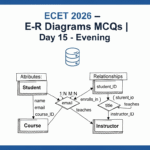
Concept Notes: DBMS – Database Fundamentals
🔹 1. What is a Database?
A database is a collection of logically related data, organized so it can be easily accessed, managed, and updated.
🔹 2. What is DBMS?
DBMS (Database Management System) is a software system that allows users to create, retrieve, update, and manage data in databases.
🔹 3. Advantages of DBMS
- Reduces data redundancy
- Ensures data integrity
- Provides data security
- Allows multi-user access
- Easy backup and recovery
🔹 4. Types of DBMS
| Type | Description |
|---|---|
| Hierarchical | Tree-like structure |
| Network | Many-to-many relationships |
| Relational (RDBMS) | Data in tables (rows + columns) |
| Object-Oriented | Data stored as objects |
🔹 5. Relational DBMS (RDBMS)
Most widely used. Data is stored in tables with rows and columns.
Examples: MySQL, PostgreSQL, Oracle, SQL Server
🔹 6. Data Models
- Entity-Relationship Model (ER Model): Visual representation using entities and relationships
- Relational Model: Organizes data in relations (tables)
🔹 7. Schema vs Instance
| Term | Description |
|---|---|
| Schema | Structure of the database |
| Instance | Actual data in the database |
🔹 8. Keys in DBMS
| Key Type | Purpose |
|---|---|
| Primary Key | Uniquely identifies a row |
| Foreign Key | References primary key in another table |
| Candidate Key | Possible keys that can act as primary |
| Composite Key | Primary key formed with more than one column |
🔹 9. SQL Basic Commands
| Type | Examples |
|---|---|
| DDL (Definition) | CREATE, ALTER, DROP |
| DML (Manipulation) | SELECT, INSERT, UPDATE, DELETE |
| DCL (Control) | GRANT, REVOKE |
🔹 10. Normalization
Process of organizing data to reduce redundancy and improve integrity.
Forms: 1NF, 2NF, 3NF, BCNF
🧠 10 MCQs – DBMS Fundamentals
1️⃣ What does DBMS stand for?
A) Database Mechanism System
B) Database Management System
C) Data Batch Management System
D) Data Basic Model Software
2️⃣ Which of the following is a type of DBMS?
A) Flat File
B) Relational
C) Indexed File
D) Sorted File
3️⃣ Which language is used for accessing databases?
A) HTML
B) SQL
C) XML
D) CSS
4️⃣ Which of these is a valid SQL command?
A) SELECT
B) READ
C) WRITE
D) PICK
5️⃣ What is the full form of RDBMS?
A) Relational DB Model Software
B) Relational Database Management System
C) Random Database Management Storage
D) Real-time DBMS
6️⃣ In an ER model, what does a rectangle represent?
A) Attribute
B) Entity
C) Relationship
D) Table
7️⃣ Which key is used to uniquely identify rows in a table?
A) Foreign Key
B) Composite Key
C) Primary Key
D) Candidate Key
8️⃣ Which of these is NOT a DDL command?
A) CREATE
B) INSERT
C) ALTER
D) DROP
9️⃣ What is normalization used for?
A) Speed up CPU
B) Add redundancy
C) Remove redundancy
D) Format database
🔟 Which SQL command is used to delete rows?
A) REMOVE
B) DROP
C) DELETE
D) ERASE
✅ Answer Key
| Q.No | Answer |
|---|---|
| 1 | B |
| 2 | B |
| 3 | B |
| 4 | A |
| 5 | B |
| 6 | B |
| 7 | C |
| 8 | B |
| 9 | C |
| 10 | C |
📖 Explanations
- Q1: DBMS = Database Management System.
- Q2: Relational DBMS stores data in tables.
- Q3: SQL is used to interact with databases.
- Q4: SELECT is a DML command to fetch data.
- Q5: RDBMS is the full form of Relational DBMS.
- Q6: In ER model, rectangles = entities.
- Q7: Primary key ensures unique rows.
- Q8: INSERT is a DML command, not DDL.
- Q9: Normalization removes redundancy.
- Q10: DELETE removes specific rows from table.
📥 Download Notes + MCQs PDF
📲 Telegram: @learnnewthingsoffcial
PDF Available with visual diagrams + syntax examples.
💬 Comment Task
💬 Comment the SQL code to create a “Students” table with ID, Name, Branch.
![]()



